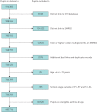Educational and health outcomes of children treated for asthma: Scotland-wide record linkage study of 683 716 children
- PMID: 31196949
- PMCID: PMC6727030
- DOI: 10.1183/13993003.02309-2018
Educational and health outcomes of children treated for asthma: Scotland-wide record linkage study of 683 716 children
Abstract
Background: The global prevalence of childhood asthma is increasing. The condition impacts physical and psychosocial morbidity; therefore, wide-ranging effects on health and education outcomes are plausible.
Methods: Linkage of eight Scotland-wide databases, covering dispensed prescriptions, hospital admissions, maternity records, death certificates, annual pupil census, examinations, school absences/exclusions and unemployment, provided data on 683 716 children attending Scottish schools between 2009 and 2013. We compared schoolchildren on medication for asthma with peers, adjusting for sociodemographic, maternity and comorbidity confounders, and explored effect modifiers and mediators.
Results: The 45 900 (6.0%) children treated for asthma had an increased risk of hospitalisation, particularly within the first year of treatment (incidence rate ratio 1.98, 95% CI 1.93-2.04), and increased mortality (HR 1.77, 95% CI 1.30-2.40). They were more likely to have special educational need for mental (OR 1.76, 95% CI 1.49-2.08) and physical (OR 2.76, 95% CI 2.57-2.95) health reasons, and performed worse in school exams (OR 1.11, 95% CI 1.06-1.16). Higher absenteeism (incidence rate ratio 1.25, 95% CI 1.24-1.26) partially explained their poorer attainment.
Conclusions: Children with treated asthma have poorer education and health outcomes than their peers. Educational interventions that mitigate the adverse effects of absenteeism should be considered.
Copyright ©ERS 2019.
Conflict of interest statement
Conflict of interest: M. Fleming has nothing to disclose. Conflict of interest: C.A. Fitton has nothing to disclose. Conflict of interest: M.F.C. Steiner has nothing to disclose. Conflict of interest: J.S. McLay has nothing to disclose. Conflict of interest: D. Clark has nothing to disclose. Conflict of interest: A. King has nothing to disclose. Conflict of interest: D.F. Mackay has nothing to disclose. Conflict of interest: J.P. Pell has nothing to disclose.
Figures



References
-
- Asher MI, Montefort S, Bjorksten B, et al. . Worldwide time trends in the prevalence of symptoms of asthma, allergic rhinoconjunctivitis, and eczema in childhood: ISAAC Phases One and Three repeat multicountry cross-sectional surveys. Lancet 2006; 368: 733–743. - PubMed
-
- Snell N, Strachan D, Hubbard R, et al. . Burden of lung disease in the UK; findings from the British Lung Foundation's “respiratory health of the nation” project. Eur Respir J 2016; 48: Suppl. 60, PA4913.
-
- Collins JE, Gill TK, Chittleborough CR, et al. . Mental, emotional, and social problems among school children with asthma. J Asthma 2008; 45: 489–493. - PubMed
Publication types
MeSH terms
Substances
Grants and funding
LinkOut - more resources
Full Text Sources
Medical
